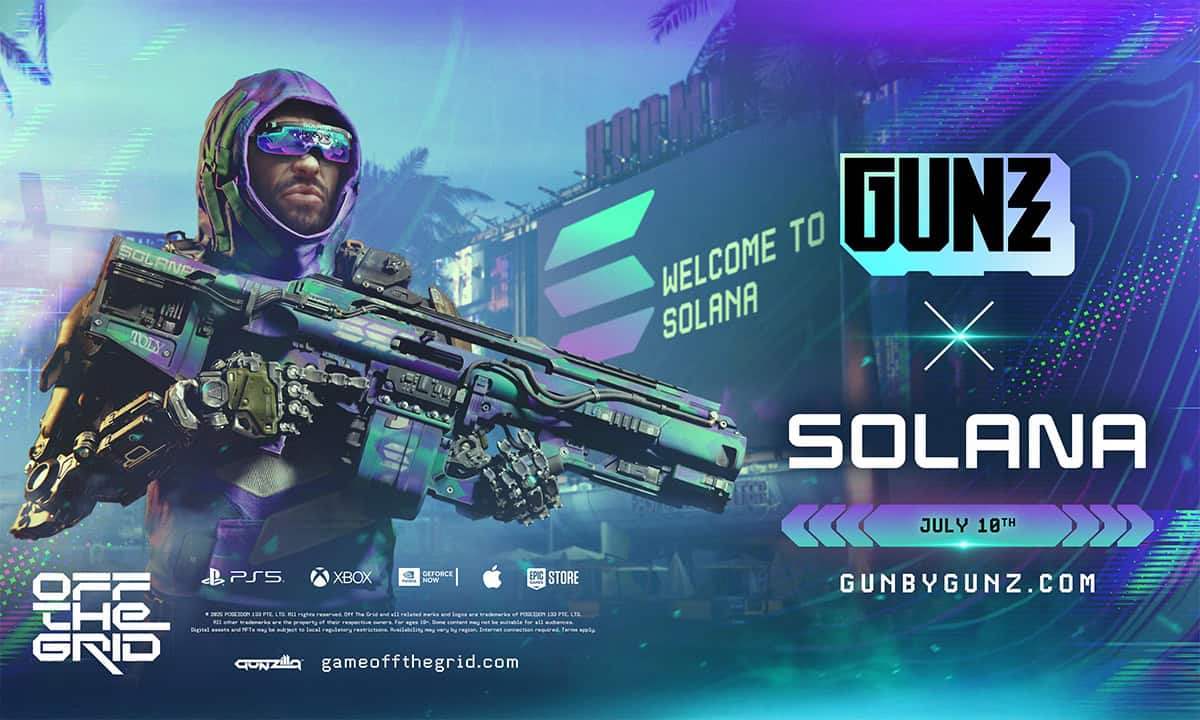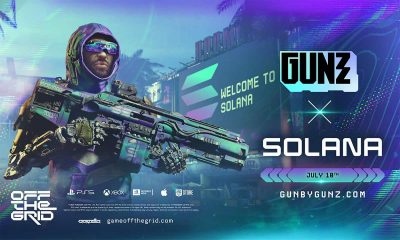Cryptocurrency
Making real-world blockchain solutions possible — Solana co-founder Raj Gokal

Raj Gokal, co-founder of blockchain protocol Solana and chief operations officer of Solana Labs, started his career in venture capital with a focus on high-growth tech business.
For seven years, Gokal focused on health tech, first with wearable sensors using Bluetooth Low Energy as a wireless protocol, then leading product management at Omada Health. He aimed to address the fractured, challenging United States healthcare system but “encountered challenges with health plans and regulators, leading me to recognize the industry’s persistent issues,” he told Cointelegraph.
After meeting Solana co-founder Anatoly Yakovenko and seeing his “vision to resolve scalability in crypto,” Gokal immersed himself in the crypto industry. “The journey has been rewarding over these past five years.”
Recently, Gokal sat down for an interview with Cointelegraph to discuss Web3, scalability, tokenization and more.
Cointelegraph: There has been a noted absence of substantial real-world use cases in the Web3 domain. This contributes to the perception that there’s no product-market fit for the industry. What are a few real-world use cases Web3 is currently prioritizing?
Raj Gokal: A real-world use case that comes to mind is decentralized physical infrastructure networks, or DEPIN. Developers often lead the way, as seen with projects like Helium, which established a decentralized 5G network with 1.5 million hotspots before transitioning to Solana. Similarly, Hivemapper launched its decentralized maps, utilizing a distributed global workforce equipped with dashcams. This is now an alternative to a centralized organization like Google deploying tens of thousands of cars that it owns to map the roads.
The Hivemapper network remapped 8% of the world’s roadways in just a few months, which is very much a real-world application of Web3 on Solana. These ventures showcase the viability and significance of leveraging low-cost, scalable blockchain technology to create innovative solutions. Developers across the world come together without any central authority and create successful business models with tangible value.
CT: Your ambition was to resolve scalability challenges within Web3. What architectural considerations are essential when building real-world solutions on layer-1 platforms?
RG: The benefits of parallelized transaction processing and validation are foundational, offering various advantages for developers and users. Solana pioneered these features, optimizing for speed with 400-millisecond block times and near-instant confirmations. We hear testimonials from users that a transaction was completed on Solana even before they could switch tabs. This fast, seamless experience builds trust and user satisfaction. Additionally, low transaction costs are crucial.

Compatibility and composability are essential, too, allowing various applications to work together. Decentralization is a linchpin, ensuring longevity and reliability. For instance, on Solana, we have close to 3,000 validators and the highest Nakamoto coefficient of 33 across all blockchains. While achieving these feats within a decentralized, high-performance network is challenging, it has been achieved through rigorous effort and innovation.
There are several such architectural decisions that make real-world solutions possible on blockchains. It is often not just one feature — it is the convergence of several architectural considerations that make it viable and scalable.
I also think blockchain networks must be battle-tested across multiple cycles. As ecosystems thrive through difficult market conditions, it provides developers, users and investors confidence that the network is here to stay.
CT: Let’s move on to Web3’s approach to mobile and payments. Solana has taken steps to introduce Solana Pay. You also recently launched the Saga phone. What are the motivations behind this, and how does it impact the broader mobile and payments landscape?
RG: The Solana Saga phone has shown that there is a huge opportunity for handset and operating system makers to create a sandbox where developers can build what they want with token incentives and without any restrictions on nonfungible tokens. Since the launch of the Saga, Apple and Google have eased their stance on digital assets in their application stores.
We have seen similar initiatives in the past, when Tesla created a new market for electric vehicles. It started with the Roadster, which initially only sold a few thousand cars. But over time, it has made it a more accessible mass-market product. We should see a similar trajectory for Web3-friendly mobile phones over the coming years, and Saga is just the beginning.
Solana Pay, on the other hand, operates at the crossroads of fostering a more accessible and open payments ecosystem. If you look at the Bitcoin white paper, the initial purpose of Bitcoin and the whole idea of digital money was to facilitate permissionless peer-to-peer online payments. That was the initial vision for cryptocurrencies.

By providing an alternative platform, Solana aims to influence these giants to adopt more user-centric and app-friendly frameworks. As for Solana Pay itself, it’s designed to enable any developer to integrate QR code-based payment features across various contexts, whether in point-of-sale systems, mobile apps or web-based services.
This has sparked initiatives like Decaf in over 30 countries, focusing on cross-border remittances. Sling, another Solana-powered platform, competes with Venmo on a global scale. Over the next few years, we can anticipate an upsurge in grassroots and enterprise-driven solutions that leverage crypto for payments.
CT: Let’s talk about real-world asset tokenization. While this area holds immense potential, it hasn’t fully taken off. What are the barriers preventing the widespread adoption of real-world asset tokenization, and how can these hurdles be overcome?
RG: Real-world asset tokenization indeed presents enormous opportunities, especially in sectors like real estate. Initiatives such as Parcl and Homebase are pioneering this space, though it requires time for adoption. For instance, Homebase is focused on individual properties that are tokenized and fractionalized so that you can get rental income that is globally accessible to anyone.
This space is about providing assets that people actually want and then making sure the narrative is good enough to win mindshare and convince users that real-world asset tokenizations are now something that’s possible. The idea looks sound on paper, but often, it takes time to execute, and we just need founders who are good at carrying the messaging for this space and have strong product skills. Success hinges on creating accessible, user-friendly, trustworthy platforms that offer real value to users, but also in delivering the narrative to the target users.
Over the next few years, the collective efforts of dedicated teams and the introduction of innovative platforms will likely drive increased adoption and establish a strong presence in the market.
CT: What strategies can mitigate risks associated with potential outages or technical difficulties within the Web3 ecosystem?
RG: Addressing liveness [i.e., the guarantee that a protocol can exchange messages between the network nodes, allowing them to reach a consensus] and reliability issues is essential to ensure seamless operations in real-world applications. The industry has learned from mistakes committed in the past and has actively implemented solutions to minimize outages. This will be critical for institutional adoption, as they will want to see reliable infrastructure before embracing this innovation at scale.
Networks like Solana have made significant strides in enhancing liveness and minimizing potential issues. Collaborative efforts between multiple validator clients, diverse solutions and continuous refinement of the ecosystem have led to increased stability and dependability. While the Web3 space is still evolving, the focus on these aspects will likely lead to even greater reliability over time.

CT: What would you define as a product-market fit for layer-1 protocols and the broader Web3 ecosystem? What would the user experience look like in your view?
RG: I think there are two stages of product-market fit. One is where founders and developers are able to either fund themselves or get funding to launch products that work toward end-user product market fit. And I believe we have achieved that level of product-market fit. Even in the depths of the bear market, you still see quality teams get funded, things are getting pushed forward, and new products are being launched.
Then, there is the second level, which is end-user product-market fit. And I would say that is a stage where the majority of the value that users are getting is not speculative from buying and holding assets but is from earning by contributing to networks, where the value is being shared back to the user. That’s why sectors like DEPIN, even though there are not 100 DEPIN examples, are happening. Users are using their hardware to earn money in crypto by supporting a network that adds real-world value to users. It’s exciting, and I’ll admit that it’s early.
Cryptocurrency
Popular Trader Dumps 5 Altcoins to Focus on Meme Coins With 100X Potential

TL;DR
- One well-known crypto trader sold TIA, ONDO, and other holdings to chase major gains in the meme coin niche – a move that sparked both support and skepticism across the crypto community.
- Despite Bitcoin’s dominance above 64%, some analysts believe an altseason is near, with low-cap tokens such as HNT and ONDO expected to lead the charge.
Cashing Out
While talk of an upcoming altseason continues to buzz across the crypto space, popular X user Crypto Beast has decided to offload some of their bags. The trader revealed the sell-off occurred on July 7 and included the tokens Celestia (TIA), Ondo (ONDO), Ethena (ENA), Quant (QNT), and Pyth Network (PYTH).
It is worth mentioning that all of the aforementioned have posted some gains on a 24-hour scale. TIA leads the charge with a spike of around 10%, while the rest have recorded more modest increases.
The crypto enthusiast claimed the sold altcoins have utility but questioned whether this is needed in the space. “They’re good for one thing: making VCs richer,” they added.
Crypto Beast has now shifted focus to hunting meme coins with 100x potential. Some X users commenting on the post supported the decision, stressing the importance of profit-taking. Others, though, wondered why the trader would prioritize meme coins, considering the hype for these tokens had significantly reduced in the past several months.
Recall that the sector was booming towards the end of last year, with its total market cap surging past $120 billion. Currently, the capitalization stands at less than $60 billion (per CoinGecko’s data).
Was This the Right Time?
Bitcoin (BTC) continues to outperform its rivals, and as of this writing, its market dominance is beyond 64%. However, multiple industry participants believe the altcoins have yet to catch up with the biggest cryptocurrency and steal the show.
X user Chiefy predicted that the next altcoin “super-cycle” will start in July. “This time, low caps will pump 175x and ignite the most powerful altseason,” they forecasted. The analyst thinks Sui Network (SUI), Helium (HNT), Render (RENDER), Filecoin (FIL), and Ondo (ONDO) are among the top contenders for explosive rallies.
It’s worth noting, though, that SUI should not be placed in the same ‘low-cap’ category, as it’s the 15th-largest cryptocurrency with a market cap of over $10 billion.
Carl Moon – an X user with over 1.5 million followers – chipped in, too. He claimed that the altcoins “will go parabolic” once the combined market capitalization of all digital assets (excluding BTC and ETH) soars above $1.15 trillion. Currently, the figure stands well below $1 trillion.
Binance Free $600 (CryptoPotato Exclusive): Use this link to register a new account and receive $600 exclusive welcome offer on Binance (full details).
LIMITED OFFER for CryptoPotato readers at Bybit: Use this link to register and open a $500 FREE position on any coin!
Cryptocurrency
GUNZ Announces $GUN Token Expansion to Solana

[PRESS RELEASE – Robinson Point, Singapore, July 7th, 2025]
GUNZ, the L1 blockchain ecosystem that powers the groundbreaking AAA game Off The Grid (OTG), today announced the expansion of its $GUN token to the Solana blockchain. This strategic move brings part of the $GUN token’s circulating supply to Solana, enhancing accessibility for U.S. (and global) users while reinforcing GUNZ’s leadership in the blockchain gaming sector. On the 10th of July $GUN lands on Solana, bringing lightning-fast access and next-gen infrastructure to a whole new wave of gamers and community members.
Strategic Alignment with Solana: A Multi-Chain Vision
Under the bold banner, “$GUN is Coming to Solana,” GUNZ is embracing Solana’s high-speed, low-cost blockchain infrastructure and robust ecosystem to amplify its multi-chain strategy, aptly summarized as “Too Big for One Chain.” This move represents the latest step in a clear multichain strategy, setting the stage for additional expansions to other prominent blockchains in the future. The bridging process to Solana will be facilitated by LayerZero, a leader in blockchain interoperability and seamless cross-chain transactions.
Currently, $GUN is available on multiple blockchains and platforms, including GUNZ Layer 1 and AVAX C-chain.
This alignment radically increases accessibility to the token and unlocks new opportunities for partnerships, campaigns, and community engagement by leveraging Solana’s global reach.
To celebrate this milestone, GUNZ will launch a limited-edition Solana-themed NFT content pack. Details on how to claim this exclusive offering will be announced soon, adding excitement for the growing Off The Grid community.
Off The Grid and the GUNZ Ecosystem: A Clarified Vision
GUNZ is renowned for Off The Grid, the first AAA game with an onchain economy, available across platforms like Epic Games Store, Xbox, PlayStation, and soon Steam. Within OTG, the $GUN token serves as a utility token, enabling players to purchase in-game items, engage in asset trading, and participate in blockchain-powered gameplay interactions. Following the Solana integration, players will be able to deposit Solana-based $GUN directly into their in-game wallet, enabling fast, reliable, and convenient transactions within OTG’s immersive digital economy.
With over 17 million wallets registered in the GUNZ ecosystem, GUNZ is poised for strong growth. This milestone will boost ecosystem activity and token utility.
Leadership Perspective
“Launching $GUN on Solana reflects our long-term commitment to building a truly global, player-first ecosystem,” said Vlad Korolov, CEO at Gunzilla Games. “Solana’s speed and scalability allow us to reach new communities with greater efficiency and reliability. This is more than a technical upgrade—it’s a major step toward making blockchain gaming seamless, inclusive, and ready for the mainstream.”
Looking Ahead
GUNZ is set to share additional updates in the coming weeks, including details on the highly anticipated Steam release of Off The Grid and further global token availability. As the ecosystem gears up for mass adoption, the crypto community is encouraged to stay tuned for announcements that will solidify GUNZ’s position as a trailblazer in blockchain gaming.
Risk & Regulatory Disclosure
$GUN is an in-game utility asset. It has not been registered, qualified, or approved as a security, capital-markets product, or digital payment token in any jurisdiction. No regulator has reviewed this material. This release is not an offer, solicitation, or investment advice, and $GUN is not offered to U.S. persons. The token’s value may fall to zero and is not covered by investor-compensation schemes (including those under EU MiCAR). Always verify eligibility before acquiring or using $GUN.
About Gunzilla
Founded in 2020, Gunzilla Games is an independent AAA video game developer and publisher behind Off The Grid — a groundbreaking battle royale now live on PC, PlayStation, and Xbox. Gunzilla is also the creator of GUNZ, a gamer-first blockchain ecosystem, and the proud owner of Game Informer, the largest gaming media outlet.
Driven by a passion for innovation, Gunzilla is dedicated to pushing the boundaries of what’s possible in gaming—delivering cutting-edge experiences that empower players, developers, and the industry as a whole.
For more information, users can visit GunzillaGames.com.
Official X of Gunzilla Games – https://x.com/GunzillaGames
Official X of GUNbyGUNZ – https://x.com/GUNbyGUNZ
Official X of Off The Grid – https://x.com/PlayOffTheGrid
Binance Free $600 (CryptoPotato Exclusive): Use this link to register a new account and receive $600 exclusive welcome offer on Binance (full details).
LIMITED OFFER for CryptoPotato readers at Bybit: Use this link to register and open a $500 FREE position on any coin!
Cryptocurrency
Ethereum Eyes 16.7M Gas Cap Under Vitalik Buterin’s New Proposal

Ethereum co-founder Vitalik Buterin and Ethereum Foundation researcher Toni Wahrstätter have proposed a ceiling on how much gas a single transaction can use, and aim to tighten security while preserving efficiency as the protocol matures.
The draft proposal, EIP-7983, sets a 16.77 million gas limit per transaction. Interestingly, this is a significant change from the current architecture, where a single transaction can consume an entire block’s gas allowance.
Developers argue this open-ended design exposes Ethereum to denial-of-service (DoS) risks, inconsistent network load, and slower block verification, especially as the chain supports increasingly complex DeFi and zero-knowledge applications.
EIP-7983
By introducing a hard cap, Buterin and Wahrstätter seek to enforce more predictable resource usage without significantly disrupting typical user activity, noting that most transactions currently fall well below the proposed threshold.
Transactions of more than the 16.77 million gas cap would be rejected during validation. Such a move would ensure oversized transactions cannot enter blocks, while the block gas limit itself would remain adjustable by validators under existing consensus rules.
The authors frame the move as part of a broader effort to simplify Ethereum’s base layer and improve network reliability, which essentially echoes Buterin’s recent calls to streamline protocol design inspired by Bitcoin’s minimalist ethos.
Easing zkVM Constraints
Developers working on zkVMs and parallel execution engines have highlighted difficulties in handling transactions with unpredictable gas sizes. They believe a fixed ceiling could ease engineering constraints and allow better subdivision of workloads across threads.
The cap is also expected to reduce the risk of any single transaction monopolizing block resources, thereby improving consistency in execution times and block propagation. While the proposed limit may require some large deployments to split transactions into smaller segments, it aligns with Ethereum’s longer-term goal of supporting modular and provable systems while maintaining user experience.
EIP-7983 builds on the now-stagnant EIP-7825 but with a lower ceiling. The proposal is currently in draft status and is now open for community discussion as developers assess its practical impact on the network.
Binance Free $600 (CryptoPotato Exclusive): Use this link to register a new account and receive $600 exclusive welcome offer on Binance (full details).
LIMITED OFFER for CryptoPotato readers at Bybit: Use this link to register and open a $500 FREE position on any coin!

 Forex3 years ago
Forex3 years agoForex Today: the dollar is gaining strength amid gloomy sentiment at the start of the Fed’s week

 Forex3 years ago
Forex3 years agoUnbiased review of Pocket Option broker

 Forex3 years ago
Forex3 years agoDollar to pound sterling exchange rate today: Pound plummeted to its lowest since 1985

 Forex3 years ago
Forex3 years agoHow is the Australian dollar doing today?

 Cryptocurrency3 years ago
Cryptocurrency3 years agoWhat happened in the crypto market – current events today

 World3 years ago
World3 years agoWhy are modern video games an art form?

 Commodities3 years ago
Commodities3 years agoCopper continues to fall in price on expectations of lower demand in China

 Economy3 years ago
Economy3 years agoCrude oil tankers double in price due to EU anti-Russian sanctions



























